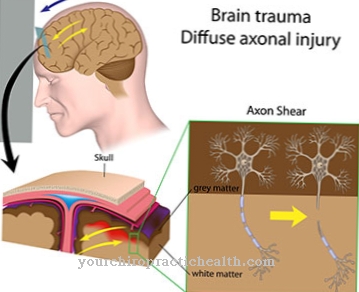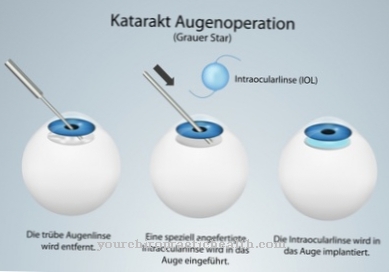Under the Cat cry syndrome, also as Cri-du-Chat Syndrome known, medical professionals understand a rare hereditary disease. In infants, this is expressed, among other things, by the typical cat-like screams that gave the disease its name.
What is cat cry syndrome?
.jpg)
© Kateryna_Kon - stock.adobe.com
The Cat cry syndrome is a disease that can be traced back to a change in the genetic make-up. According to statistics, one in 50,000 children has CDC syndrome. Girls are affected significantly more often than boys (the ratio is around 5: 1).
The cat cry syndrome manifests itself through numerous characteristics, which occur to different degrees in individual cases. Due to this fact, the disease is often not recognized or recognized very late. Symptoms include malformation of the larynx, short stature, malformations of the head or face and restricted motor and cognitive abilities.
The cat cry syndrome is not curable; Depending on the individual characteristics, the condition of the individual can be improved through appropriate therapeutic and social support. Life expectancy is usually hardly affected unless other illnesses occur.
causes
The causes for that Cat cry syndrome lie in a change in the genome. Basically every person has 46 pairs of chromosomes. CDC sufferers show a loss of chromosome 5. This creates a gene structure that deviates from the norm and causes the symptoms.
The chromosome change can occur either through a spontaneous mutation or due to a hereditary predisposition. In most cases it is a spontaneous change. If the cat cry syndrome is hereditary, one of the parents carries the chromosome change in their genetic makeup. The genetic information contained in the missing piece is not lost, however, but is attached to another pair of chromosomes.
So it happens that the affected parent is healthy himself, but passes the CDC syndrome on to their children. About 12% of known cases arise this way.
Symptoms, ailments & signs
The cat scream syndrome is mainly expressed by the typical cat-like screaming. As a result of a malformation of the larynx, the affected child expresses itself through high-pitched noises that sound high and pressed and are associated with prolonged exhalation. Inhaling is usually difficult, which results in the characteristic panic-like breathing.
There are also other malformations. Many children with cat cry syndrome have a small head with low-set ears or a small chin or a wide bridge of the nose. The eyes can be unusually wide apart and the eyelids can have noticeable folds of skin. In addition, the sick often have short fingers or a so-called four-finger furrow, in which the fingers are traversed by a flexion fold.
The little finger occasionally exhibits an unusual internal flexion. Symptoms such as strabismus and nearsightedness can occur in the eye area. Furthermore, malocclusions can occur. These are accompanied by a greatly slowed development of language skills. Those affected then speak, for example, very indistinctly or have problems with spoken language.
Speech comprehension usually develops normally. The high-pitched screaming usually disappears within the first few years of life. The high-pitched voice remains, however, and leads to mental problems for many sick people. In addition, a crooked spine can develop over the course of life.
Diagnosis & course
The Cat cry syndrome can be diagnosed during pregnancy. A chromosome analysis can provide information about whether the fetus is suffering from a genetic change. However, this investigation will only take place if there is reasonable suspicion.
This can be the case, for example, if one of the parents has already had a child with CDC syndrome and there is a likelihood that other offspring will also be affected. Under these circumstances an amniotic fluid or tissue examination will take place. After birth, the cat cry syndrome can often be diagnosed based on physical abnormalities.
Infants affected by CDC syndrome usually have a very low birth weight and a smaller head. The eyes are often set wide apart, while the ears are noticeably low. The typical high-pitched, cat-like cry of sick infants, which is caused by a malformation of the larynx, is a clear sign of the cat's cry syndrome.
Complications
Due to the cat cry syndrome, very loud and high-pitched screaming occurs even in small children and infants. Parents and relatives in particular can develop severe psychological complaints or depression as a result. The quality of life of the patient and the parents is significantly reduced and restricted by the cat cry syndrome.
The children themselves suffer from growth and development disorders. There is also a reduced birth weight and a misalignment of the jaw. The teeth can show misalignments and deformities. Those affected have weak muscles and squint. There is also a decreased intelligence or a retardation, so that the patient may be dependent on the help of other people in his everyday life.
Cat cry syndrome may reduce life expectancy. There is no cure for cat cry syndrome. For this reason, only therapies that are intended to alleviate the symptoms can be used. Parents in particular often need psychological treatment. If the cat cry syndrome is diagnosed during pregnancy, the pregnancy can be terminated under certain circumstances.
When should you go to the doctor?
Immediately after birth, newborns show visual changes or other abnormalities that should be examined by a doctor immediately. In most cases, delivery takes place in the presence of an obstetrician or doctor. They take over all necessary initial examinations of the child in a routine process and independently initiate the necessary steps to clarify the cause in the event of irregularities. In the case of a home birth, this process is carried out by a midwife, so that no further measures need to be taken by the newborn's parents.
If the birth takes place without the presence of an obstetrician, a comprehensive medical examination of the mother and child should be initiated immediately after the birth. A doctor is particularly needed if the infant has malformations of the larynx or unusual eye alignment. A misalignment of the jaw, squinting or wide apart eyes with a wide nose at the same time are indications of an existing disease.
If the newborn's head and chin are very small compared to other infants, the observations should be discussed with a doctor. If the child's screams sound like a cat, this is considered worrying and should be examined. If the birth weight is very low, check-ups are required so that the necessary steps can be taken to ensure the child's survival.
Treatment & Therapy
It is true CDC syndrome not curable; but if the disease is recognized early, the personal development of the person affected can be positively promoted by appropriate therapies.
This includes speech and movement therapies as well as appropriate early intervention and occupational therapy. The exact course of the disease depends on the degree of severity and the intensity of the support.
A lifelong limitation of motor and cognitive abilities is likely, so that most CDC sufferers remain dependent on help and / or care. How exactly the clinical picture of the individual will develop, however, cannot be foreseen.
Outlook & forecast
Cat cry syndrome cannot be prevented or cured. This is precisely why early and targeted support for affected patients is important. This should consist of both physical and psychological support. If such support is not provided, affected children may not be able to compensate for the severely delayed mental and physical development later. This can make it impossible to learn certain actions that are necessary in everyday life. Movements such as walking, getting dressed or speaking can then represent insurmountable hurdles. However, if early support measures are initiated, they can have a positive influence on the course of the disease and significantly increase the quality of life. The consistent stimulation of patients in various areas of everyday life can lead to them being able to lead a largely self-determined existence in adulthood.
Speech therapy, for example, can help to positively influence typical language deficits even in childhood. In order to achieve the best possible prognosis for the disease, therapeutic measures should be tailored to each patient. Even if the abilities of these people are often limited and lifelong support is necessary, the disease does not reduce the life expectancy of children born with the cat cry syndrome.
prevention
Since that Cat cry syndrome often occurs spontaneously, the disease cannot actually be prevented. However, if a corresponding genetic change is known in one of the parents, at least early examinations during pregnancy are possible to provide information about a possible disease in the child. Parents then have the opportunity to decide for or against an abortion.
Specialists can also determine the risk of CDC if one of the parents' children is already affected by the cat-cry syndrome. If an infant is born with CDC syndrome, parents should give it the most intensive support possible in order to optimally support personal development.
Aftercare
Since a causal therapy for the cat cry syndrome is just as impossible as a cure, there are no aftercare options in the true sense of the word. As part of the therapy, early intervention and lifelong physiotherapy, occupational therapy and speech therapy are recommended. It is imperative to support those affected physically and emotionally for life, even after successful therapies and with good social integration.
In the early childhood of Cri-du-Chat patients, intensive mental and physical stimulation, as well as speech therapy treatments, are of particular relevance. Vocational training measures are of great importance at an advanced age and especially in the late phase of youth. Social outsourcing due to the inadequate cognitive development of Cri-du-Chat patients must be prevented urgently.
Various self-help groups accompanying everyday life offer support in shaping work and life. It is important that those affected are encouraged and not overwhelmed. In addition to taking advantage of psychological, social and physiological support, regular general medical, ophthalmological, ENT and dental care forms the basis for a life with little suffering with the Cri-du-Chat syndrome. Despite early encouragement, the behavior and fine motor skills and articulation of those affected usually remain conspicuous and have a stigmatizing effect. Even with good therapy, those affected are lifelong dependent on support and, if necessary, care.
You can do that yourself
Since the cause of the cat cry syndrome is a mutation in the chromosomes, it is not possible for those affected to heal themselves from it. However, the syndrome is often associated with other physical impairments, which can vary from patient to patient.
Different types of developmental disorders often occur. With occupational therapy, physiotherapy and physiotherapy, these can be limited from the start and the delays in development can often be largely compensated for through targeted support. The same applies to other side effects of the cat cry syndrome. The frequently occurring susceptibility to infections and the often observed dental problems can each be countered preventively. The linguistic disorders that often occur due to the slowed development can be alleviated or even eliminated with speech therapy measures.
As a rule, it has been shown that most of the accompanying symptoms of the cat cry syndrome can be largely limited by intensive support and treatment measures that are started as early as possible. Such therapeutic treatments can improve the quality of life of those affected. Nevertheless, the syndrome, with its physical effects and symptoms, will usually also have psychological effects. Therefore, caring, psychological support is also advisable in many cases.


.jpg)





















.jpg)



